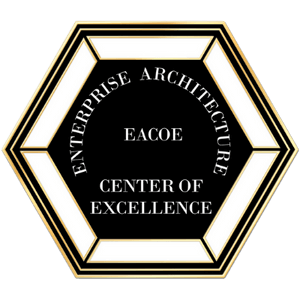TOGAF® Certified?
What is next?
If you already have a “certification” in Enterprise Architecture and are actually trying to “DO” and “BUILD” Enterprise Architectures and have not attended an EACOE Enterprise Architecture Workshop, the chances are high you have “gaps” and “needs” in your Enterprise Architecture development efforts.
A growing number of EACOE Enterprise Architecture Workshop attendees already have an Enterprise Architecture “certification” prior to attending. We have seen a pattern of 26 “items” noted by these attendees as “gaps” or “needs” that were recognized after these attendees received their “other” certification and have been addressed at EACOE.
Included below are some of the 26 items many of our attendees mentioned were missing in their Enterprise Architecture development process before attending the EACOE Enterprise Architecture workshop:
Business Initiatives as a deliverable
Clarity and Reason in Modeling
Structured Human-Consumable Understandings
Standardized and Executable process
Verifiable Correctness / Traceability
Current Business/Technology Compatibility
Discrete and Integrated Methods
Methodology Management
Project Handbook Preparation
Consultant/Vendor Demonstration Ability
Enabling Tools
Customizability and Customization Services
Organization Implementation and Integration Services
Here’s what typical TOGAF® certified individuals have said about EACOE Workshops...
“I came into EA by default, but it has since captured my interest. I quickly mastered the literature, took the exam, and passed. But since then, I have been very eager to put the knowledge into practice. It is not enough to know the literature; you should be able to produce an actionable Architecture. My goal is to address this gap, and it is more of a personal goal.”
Emeka U.
“I found the workshop extremely valuable. You kept talking about putting it into practice on “Monday morning”, which at the time seemed somewhat unreasonable. However, I actually was able to do just that. I was amazed. I find myself thinking in Enterprise Architecture terms now more so than ever, breaking things into definitions and specific parts and mapping it back to each cell on the framework. In fact, I was able to develop a governance model for the ministry in a manner that that defined roles, responsibilities and decision-making based on functions and sub-functions. They LOVED it!!! Understood it right away and want to extend my contract.
All in all, it was an amazing week for me. The only issue I had was that it should have been longer! I feel like I have so much more to learn.”
Karen-Ann Moore
“Thank you so much for such insightful and informative sessions last week. It’s incredible how the total concept of EA has changed for me to be SO much more than just DoDAF/TOGAF.”
Nida Khan
Ready to go beyond TOGAF®?
Your TOGAF® training has provided you with the definitions and descriptions of the EA process. With that knowledge, you are well-prepared to get the most out of attending the Enterprise Architecture Center Of Excellence (EACOE) practitioner-based Workshop to move to a higher level in your career; move to a practitioner-based Enterprise Architecture understanding that will let you take what you've learned, enhanced by the hands-on experience you now have, to achieve the next level in your EA career.
Your next step is an EACOE practitioner’s workshop where you will take what you have learned and actually conduct an Enterprise Architecture project. We provide everything you need—tools, methodology, frameworks, templates—and teach you how to use them as you create your own EA.
To register for your career-enhancing workshop, click the button below. We hope to meet you real soon and look forward to hearing your success stories!
Comparing two leading Enterprise Architecture methodologies and frameworks:
The Open Group (TOGAF®) and The Enterprise Architecture Center Of Excellence (EACOE).
Authored By Bernard Baillargeon
Comparing The Open Group and EACOE on these points:
Business Initiatives
Directed Guidance
Consistency and Simplicity
Structured Precise Definitions for Human Communication and Understanding
Clarity and Reasoning in Modeling
Discover Value in the Transformation from Model to Model
Acquiring Skills, not Passing Multiple Choice Tests
Identify Contemporary Business’ Multiple Architect Roles

